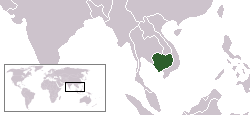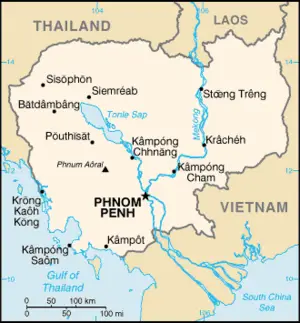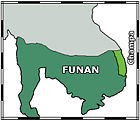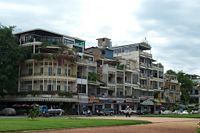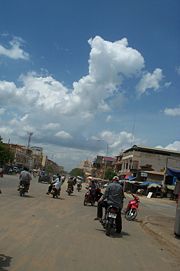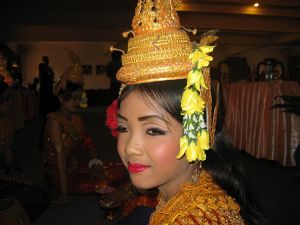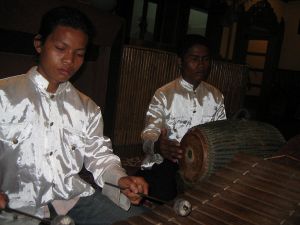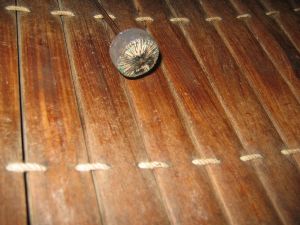Cambodia
PreńÉh R√©ach√©anach√Ęk K√ĘmpŇ≠ch√©a Kingdom of Cambodia |
||||||
|---|---|---|---|---|---|---|
|
||||||
| Motto:  Nation, Religion, King |
||||||
| Anthem: Nokor Reach "Majestic Kingdom" |
||||||
| Capital (and largest city) | Phnom Penh 11¬į33‚Ä≤N 104¬į55‚Ä≤E | |||||
| Official languages | Khmer | |||||
| Official script | Khmer script | |||||
| Ethnic groups  | 90% Khmer 5.0% Vietnamese 1.0% Chinese 4.0% other |
|||||
| Demonym | Khmer or Cambodian | |||||
| Government | Unitary parliamentary democracy and Constitutional monarchy | |||||
|  -  | King | Norodom Sihamoni | ||||
|  -  | Prime Minister | Hun Sen (CPP) | ||||
|  -  | Senate President | Chea Sim (CPP) | ||||
|  -  | President of National Assembly | Heng Samrin (CPP) | ||||
| Legislature | Parliament | |||||
|  -  | Upper House | Senate | ||||
|  -  | Lower House | National Assembly | ||||
| Formation | ||||||
|  -  | Funan Kingdom | 68  | ||||
|  -  | Chenla Kingdom | 550  | ||||
|  -  | Khmer Empire | 802  | ||||
|  -  | French Colonization | 1863  | ||||
|  -  | Independence from France | November 9, 1953  | ||||
|  -  | Monarchy Restored | September 24, 1993  | ||||
| Area | ||||||
|  -  | Total | 181,035 km² (88th) 69,898 sq mi  |
||||
|  -  | Water (%) | 2.5 | ||||
| Population | ||||||
|  -  | 2011 estimate | 14,701,717[1] (66th) | ||||
|  -  | 2008 census | 13,388,910  | ||||
|  -  | Density | 81.8/km² (118th) 211.8/sq mi |
||||
| GDP (PPP) | 2011 estimate | |||||
|  -  | Total | $32.489 billion[2]  | ||||
|  -  | Per capita | $2,470[2]  | ||||
| GDP (nominal) | 2010 estimate | |||||
|  -  | Total | $13.001 billion[2]  | ||||
|  -  | Per capita | $1,040[2]  | ||||
| Gini (2007) | 43[3] (medium)  | |||||
| Currency | Riel (KHR) |
|||||
| Time zone | (UTC+7) | |||||
| Internet TLD | .kh | |||||
| Calling code | [[++855]] | |||||
| 1 | The US Dollar is often used | |||||
The Kingdom of Cambodia is a country in Southeast Asia, the successor state of the once powerful Hindu and Buddhist Khmer Empire, which ruled most of the Indochina Peninsula between the eleventh and fourteenth centuries.
In 2005, oil and natural gas deposits were found beneath Cambodia's territorial water, and once commercial extraction begins in 2009 or early 2010, the oil revenues could have a profound impact on the future of Cambodia's economy.
Cambodia became known as the site of the "killing fields" genocide from 1975 to 1979, when up to 1.5 million people were murdered by or died under communist Pol Pot's Khmer Rouge regime.
Geography
"Cambodia" is the traditional English transliteration, taken from the French "Cambodge," while "Kampuchea" is the direct transliteration, more faithful to the Khmer pronunciation. The Khmer "Kampuchea" is derived from the ancient Khmer kingdom of Kambuja. Kambuja is the ancient Sanskrit name of the Kambojas, an early tribe of north India, named after their founder Kambu Svayambhuva.
Since independence, the official name of Cambodia has changed several times, following the troubled history of the country. The following names have been used since 1954:
- Kingdom of Cambodia under the rule of the monarchy from 1953 through 1970;
- Khmer Republic under the Lon Nol led government from 1970 to 1975;
- Democratic Kampuchea under the rule of the communist Khmer Rouge from 1975 to 1979;
- People's Republic of Kampuchea under the rule of the Vietnamese-sponsored government from 1979 to 1989;
- State of Cambodia (a neutral name, while deciding whether to return to monarchy) under the rule of the United Nations transitional authority from 1989 to 1993;
- Kingdom of Cambodia reused after the restoration of the monarchy in 1994.
Cambodia has an area of about 69,900 square miles (181,040 square kilometres). The country shares a border with Thailand to its west and northwest, with Laos to its northeast, and with Vietnam to its east and southeast. In the south it faces the Gulf of Thailand.
The geography of Cambodia is dominated by the Mekong River, colloquially known as Tonle Thom or "the great river," an important source of fish. Much of the country sits near to or below sea level, and its main source of water from the Mekong reverses its water flow in the wet season into the neighboring Tonle Sap River.
Cambodia falls within several geographic regions. The largest part of the country‚ÄĒabout 75 percent of the total‚ÄĒconsists of the Tonle Sap Basin and the Mekong Lowlands. This densely populated plain, which is devoted to wet rice cultivation, is the heartland of Cambodia. To the southeast is the Mekong Delta, which extends through Vietnam to the South China Sea. The Cardamom Mountains the Elephant Range lie to the southwest, and the Dangrek Mountains are to the north. Higher land to the northeast and to the east merges into the Central Highlands of southern Vietnam.
About 75 percent of the country lies at elevations of less than 330 feet (100 metres) above sea level. The highest elevation is Phnom Aoral, near Pursat in the center of the country, at 5948 feet (1813 metres).
Temperatures range from 50¬į to 100¬įF (10¬į‚Äď38¬įC). Southwest monsoons blow inland bringing moisture-laden winds from the Gulf of Thailand and Indian Ocean from May to October. The heaviest precipitation is from September to October. The northeast monsoon ushers in the dry season, which lasts from November to March, with the driest period from January to February. Natural hazards include flooding and occasional droughts.
Natural resources include timber, gemstones, some iron ore, manganese, phosphates, and hydropower potential.
Illegal logging throughout the country, and strip mining for gems in the western region along the border with Thailand, have resulted in soil erosion, habitat loss and declining biodiversity. The destruction of mangrove swamps threatens natural fisheries. In rural areas, a majority of the population do not have access to potable water. Toxic waste dumping from Taiwan sparked unrest in Kampong Saom (Sihanoukville) in December, 1998.
Phnom Penh is the largest population center, with two million of Cambodia's 15 million people. Mondulkiri, the hill province in the northeast bordering Vietnam, is the largest province by area but ranks lowest in population density.
History
Prehistoric Cambodia is sparsely known, as a large area of modern-day Cambodia was under water at 6000 years ago. Evidence of cave dwellers has been found in the northwest. Carbon dating indicated ceramic pots found in the area were made around 4200 B.C.E. Archaeological evidence indicates that a Neolithic culture that may have migrated from southeastern China inhabited parts of the region during the first and second millennia B.C.E.
The first advanced civilizations appeared in the first millennium C.E. During the third, fourth, and fifth centuries, the Indianised states of Funan and Chenla coalesced in what is now present-day Cambodia and southwestern Vietnam. These states had close relations with China and India. Their collapse was followed by the rise of the Khmer Empire, a civilization which flourished in the area from the ninth century to the thirteenth century.
The Khmer Empire remained powerful until the fifteenth century. A series of capitals was constructed at Angkor during the empire's zenith. Angkor Wat, the most famous and best preserved religious temple at the site, is a symbolic reminder of Cambodia's past as a regional power.
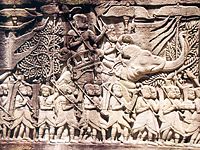
After a long series of wars with neighboring kingdoms, Angkor was sacked by the Thai and abandoned in 1432. The court moved to Lovek where the kingdom sought to regain its glory through maritime trade. The attempt was short-lived, however, as continued wars with the Thai and Vietnamese resulted in the loss of more territory and the conquering of Lovek in 1594. During the next three centuries, The Khmer kingdom alternated as a vassal state of the Thai and Vietnamese kings.
In 1863 King Norodom, who had been installed by Thailand, sought the protection of France. In 1867, the Thai king signed a treaty with France, renouncing suzerainty over Cambodia in exchange for the control of Battambang and Siem Reap provinces. The provinces were ceded back to Cambodia by a border treaty between France and Thailand in 1906.
Cambodia continued as a protectorate of France from 1863 to 1953, administered as part of the French colony of Indochina. After war-time occupation by the Japanese empire from 1941 to 1945, Cambodia gained independence from France on November 9, 1953. It became a constitutional monarchy under King Norodom Sihanouk.
In 1955, Sihanouk abdicated in favor of his father in order to be elected Prime Minister. Upon his father's death in 1960, Sihanouk again became head of state, taking the title of prince. As the Vietnam War progressed, Sihanouk adopted an official policy of neutrality until 1970 when he was ousted by a military coup led by Prime Minister General Lon Nol and Prince Sisowath Sirik Matak, while on a trip abroad. From Beijing, Sihanouk realigned himself with the communist Khmer Rouge rebels who had been gaining territory in the remote mountains and urged his followers to help in overthrowing the pro-United States government of Lon Nol, hastening the onset of civil war.
Operation Menu, a series of secret B-52 bombing raids by the United States on suspected Viet Cong bases and supply routes inside Cambodia, was acknowledged after Lon Nol assumed power; U.S. forces briefly invaded Cambodia in a further effort to disrupt the Viet Cong. The bombing continued and, as the Cambodian communists began gaining ground, eventually included strikes on suspected Khmer Rouge sites until 1973. Estimates of the number of Cambodians killed during the bombing campaigns vary widely. The Khmer Rouge reached Phnom Penh and took power in 1975, changing the official name of the country to Democratic Kampuchea, led by Pol Pot.
Solid estimates of the numbers who died between 1975 and 1979 are not available, but it is likely that hundreds of thousands were brutally executed by the regime. Hundreds of thousands died of starvation and disease (both under the Communist Party of Kampuchea and during the Vietnamese invasion in 1978). Some estimates of the dead range from one to three million, out of a 1975 population estimated at 7.3 million. The American CIA estimated 50,000-100,000 were executed and 1.2 million died from 1975 to 1979. Many were in some way deemed to be "enemies of the state," whether they were linked to the previous regime, civil servants, people with education, or of religion, critics of the Khmer Rouge or Marxism, or simply offered resistance to brutal treatment. Hundreds of thousands more fled into neighboring Thailand.
In November 1978, Vietnam invaded Cambodia to stop Khmer Rouge incursions across the border and the genocide of Vietnamese in Cambodia. Warfare between the Vietnamese and Khmer Rouge holdouts continued throughout the 1980s. Peace efforts began in Paris in 1989, culminating two years later in October 1991 in a comprehensive peace settlement. The United Nations was given a mandate to enforce a ceasefire, and deal with refugees and disarmament.
After the brutality of the 1970s and the 1980s, and the destruction of the cultural, economic, social and political life, it was only at the end of the twentieth century that reconstruction began and political stability returned. The democracy established following the conflict was shaken in 1997 during a coup d'état, but has otherwise remained in place.
In January 2003, there were riots in Phnom Penh prompted by rumored comments about Angkor Wat by a Thai actress wrongly attributed by a Cambodian newspaper, and later quoted by Prime Minister Hun Sen. The Cambodian government paid US$6-million in compensation for the destruction of the Thai embassy.
Politics
The politics of Cambodia formally take place, according to the 1993 constitution, in the framework of a parliamentary, representative democratic monarchy. The prime minister is the head of government, and of a pluriform multi-party system, while the king is the head of state. The prime minister is appointed by the king, on the advice and with the approval of the National Assembly. The prime minister and ministers exercise executive power.
Legislative power is vested in both the executive and the two chambers of parliament, the National Assembly and the Senate. The National Assembly has 122 members, elected for a five-year term by proportional representation. The Senate has 61 members. The king appoints two members, the lower house elects two, and the remaining fifty-seven are elected popularly. Members in this house serve five-year terms.
On October 14, 2004, King Norodom Sihamoni was selected after the surprise abdication of King Norodom Sihanouk a week before. He was crowned in Phnom Penh on October 29. The monarchy is symbolic and does not exercise political power. Norodom Sihamoni was trained in Cambodian classical dance and is unmarried. Due to his long stay in the Czech Republic (then known as Czechoslovakia) Norodom Sihamoni is fluent in the Czech language.
The judiciary should be independent from the rest of the government, as specified by the Constitution. The highest court is the Supreme Council of the Magistracy. Other, lower courts also exist. Until 1997, Cambodia didn't have a judiciary despite the nation's constitution requiring one. The judiciary put in place faces allegations of corruption and claims that it serves to silence critics.
The British Broadcasting Corporation (BBC) reported that corruption is rampant in the Cambodian political arena with international aid from the U.S. and other countries being transferred into private accounts. Corruption has also added to the wide income disparity within the population.
Cambodia is divided into 20 provinces (khett) and four municipalities (krong). There are further subdivisions into districts (‚Äúsrok‚ÄĚ), communions (‚Äúkhum‚ÄĚ), great districts (‚Äúkhett‚ÄĚ), and islands (‚Äúkoh‚ÄĚ).
Cambodia is a member of the United Nations, the World Bank and International Monetary Fund. It is an Asian Development Bank member, a member of ASEAN, and joined the World Trade Organization in 2004. In 2005 Cambodia attended the inaugural East Asia Summit. Cambodia has established diplomatic relations with numerous countries, including the US, Australia, Canada, China, the European Union (EU), Japan, and Russia.
Several border disputes persist. There are disagreements over some offshore islands and sections of the boundary with Vietnam, and undefined maritime boundaries and border areas with Thailand.
Economy
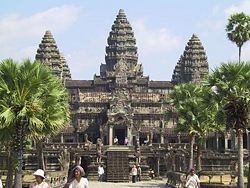
Despite recent progress, the Cambodian economy continues to suffer from the effects of decades of civil war, internal strife and rampant corruption. The per capita income is rapidly increasing, but is low compared with other countries in the region. Most rural households depend on agriculture.
War and brutal totalitarianism in the 1970s created famine. Desperate farm families consumed their rice seeds and many traditional varieties became difficult to find. In the 1980s the International Rice Research Institute reintroduced more than 750 traditional rice varieties from its rice seed bank in the Philippines. In 1987, the Australian government gave funding to assist Cambodia improve its rice production. By 2000, Cambodia was once again self-sufficient in rice.
The recovery of Cambodia's economy slowed dramatically in 1997‚Äď98, due to the Asian financial crisis, civil violence, and political in-fighting, but since then growth has been steady. In 1999, the first full year of peace in 30 years, progress was made on economic reforms and economic growth resumed at 5 percent, and continued at around that level. As of 2005, gross domestic product per capita was $2200, which ranked 178th (out of 233) countries.
There has been significant help from foreign donors, who pledged $504-million to the country in 2004, while the Asian Development Bank alone has provided $850-million in loans, grants, and technical assistance.
Tourism was Cambodia's fastest growing industry, and the second-greatest source of hard currency after the textile industry. Arrivals increased from 219,000 in 1997 to 1,055,000 in 2004. Tourist hot spots include Angkor, Phnom Penh, and Sihanoukville in the southeast which has several popular beaches. Cambodia has become a destination for sex tourism, and there is particular concern over child sex and forced prostitution.
Exports totalled $3.331-billion in 2006. Export commodities were clothing, timber, rubber, rice, fish, tobacco, and footwear. Export partners were the United States 48.6 percent, Hong Kong 24.4 percent, Germany 5.6 percent, and Canada 4.6 percent. Imports totalled $4.477-billion in 2006. Import commodities were petroleum products, cigarettes, gold, construction materials, machinery, motor vehicles, and pharmaceutical products. Import partners were Hong Kong 16.1 percent, China 13.6 percent, France 12.1 percent, Thailand 11.2 percent, Taiwan 10.2 percent, South Korea 7.5 percent, Vietnam 7.1 percent, Singapore 4.9 percent, and Japan 4.1 percent.
The civil war damaged Cambodia's transport system, despite Soviet help. Cambodia has two rail lines, totalling about 380 miles (612 kilometers) of single gauge track, from the capital to Sihanoukville on the southern coast, and from Phnom Penh to Sisophon. In 2006, only one passenger train per week operated. The nation's extensive inland waterways were important in domestic trade. Cambodia has two major ports, Phnom Penh and Sihanoukville, and five minor ones. The country has sixteen commercial airports.
Use of cars and motorcycles has increased use. Cycle rickshaws ("cyclos") are an additional option often used by visitors.
The economic challenge for Cambodia over the decade from 2006 was in fashioning an economic environment in which the private sector can create enough jobs to handle Cambodia's demographic imbalance where more than 50 percent of the population is less than 21 years old. The population lacks education and productive skills, particularly in the poverty-ridden countryside, which suffers from an almost total lack of basic infrastructure.
Demographics
United Nations Children's Fund (UNICEF) has designated Cambodia the third most land-mined country in the world, attributing over 60,000 civilian deaths and thousands more maimed or injured since 1970 to the unexploded landmines left behind in rural areas. Most victims are children herding animals or playing in the fields.
Civil war and its aftermath have had a marked effect on the Cambodian population. The median age is 20.6 years, more than half of the population younger than 25, and there are more women than men.
With a population of almost 15 million people, Cambodia is ethnically homogeneous. More than 90 percent of its population is of Khmer origin and speaks the Khmer language, the country's official language. The remainder include Chinese one percent, Vietnamese five percent, Cham, Khmer Loeu, and Indians.
The Khmer language is a member of the Mon-Khmer sub-family of the Austroasiatic language group. French, once the lingua franca of Indochina and still spoken by some, mostly older Cambodians as a second language, remains the language of instruction in various schools and universities that are often funded by France. Cambodian French, a remnant of the country's colonial past, is frequently used in government, but many younger Cambodians and those in the business-class, have favored learning English.
Most Cambodians are Theravada Buddhists, but the country also has a substantial number of predominantly Muslim Cham. The Khmer Rouge suppressed Theravada Buddhism but it has since experienced a revival. Islam (five percent) and Christianity (two percent) are also practiced.
In the communist period, communal work broke down gender barriers, and in the post-communist period, when conscription created a shortage of men in civilian occupations, women had to do more hard physical labor. Only men can enter the monkhood. Women tend to control the family finances, but have less access to positions of political and economic power. Domestic violence against women in villages is widespread, and those women have little legal recourse.
Marriage traditionally is arranged by the parents of the bride and groom. The groom begins the process by asking his parents to approach the parents of a woman to whom he is attracted. Neither is forced to take a marriage partner. The groom pays bride-wealth to the family of the bride, to buy jewelry or clothing for the bride or to pay for the wedding.
Polygyny (a form of polygamy) was legal before 1989, but true polygyny, with both wives living in the same house, was rarely practiced outside of royalty. A mistress is called a second wife, and keeping a second or third wife is not disapproved of. There is strong pressure to marry and to have children. Divorce is socially recognized, although there is pressure against it.
The domestic unit is a nuclear family consisting of parents and children. Residence after marriage is often with the parents of the bride. Aged parents often live with their adult children. Inheritances are divided equally among children without regard to gender or age order, although the child who supported the parents in their old age may be favored.
Cambodians have a strong sense of personal property. Under communism, the state promoted egalitarianism, and personal wealth was not easily detected. Since 1991, extremely wealthy individuals have appeared among government officials and business people, while most others remain poor. Cambodians have exaggerated respect for a small class of civil servants who are perhaps defined more by influence than by wealth. There is sensitivity to wealth, especially in decisions about marriage partners. Wealth was traditionally worn on the person as jewelry. Poor families live in houses of bamboo and thatch. Better-off families live in traditional wood houses on stilts. Richer families live in houses of stone or cement. Possession of cars and consumer goods mark wealth.
Culture
Khmer culture, as developed and spread by the Khmer empire, has distinctive styles of dance, architecture and sculpture, which have strongly influenced neighboring Laos and Thailand. Angkor Wat (Angkor means "city" and Wat "temple") is the best preserved example of Khmer architecture from the Angkorian era and hundreds of other temples have been discovered in and around the region. The Tuol Sleng Genocide Museum, the infamous prison of the Khmer Rouge, and Choeung Ek, one of the main "killing fields" are other important historic sites.
Rice is the staple grain, while fish from the Mekong and Tonle Sap also forms an important part of the diet. The Cambodian per capita supply of fish and fish products for food and trade in 2000 was 20 kilograms of fish per year or two ounces per day per person. Some of the fish can be made into prahok (a Khmer delicacy) for longer storage.
Cambodian cuisine is relatively unknown to the world compared to that of its neighbors Thailand and Vietnam, but has been described not as spicy as Thai cuisine. A home meal is served on a mat on the floor or with the diners seated on a bamboo platform. Adult males and guests eat first and food preparers last. Breakfast consists of rice porridge or rice noodles. Lunch and dinner may include a spiced broth with fish or meat and vegetables, fish, fresh vegetables eaten with a fish-based paste, and stir-fried vegetables with chopped meat. A strong-smelling fermented fish paste called ‚Äúpr√Ęhok‚ÄĚ is the hallmark flavoring of Khmer food. Display of fruit is a mark of abundance. ‚ÄúTeuk tnaot,‚ÄĚ a liquid tapped from sugar palms and fermented, generally is not taken with meals.
During festivals, elaborate and painstakingly seasoned dishes are prepared, such as curries, spiced fish sauces, complex stir-fries, and a variety of sweets. At temple festivals, each family presents carefully prepared dishes to the monks.
Cambodian folk music is influenced by ancient forms as well as Hindu forms. Religious dancing, depicting stories and ancient myths, are common. Some dances are accompanied by a ‚Äúpinpeat‚ÄĚ orchestra, which includes a ‚Äúching‚ÄĚ (cymbal), ‚Äúroneat‚ÄĚ (bamboo xylophone), ‚Äúpia au‚ÄĚ (flute), ‚Äúsralay‚ÄĚ (oboe), ‚Äúchappay‚ÄĚ (bass banjo), gong (bronze gong), ‚Äútro‚ÄĚ (violin), and various kinds of drums. The 1960s saw a revival in classical dance, led by Princess Norodom Bopha Devi.
Cambodian modern music is divided into two categories: "Ramvong" is slow dance music, while "ramkbach" is closely related to Thai folk music. In the province Siem Reap, a form of music called ‚Äúkantrum‚ÄĚ has become popular; originally Thai, kantrum is famous for Thai and Cambodian stars like Darkie. Modern music is usually presented in Cambodian Karaoke VCDs, usually of an actor, actress or both making the actions, usually by lip-synching the lyrics to the background song.
Bonn Om Teuk (Festival of Boat Racing), the annual boat-rowing contest, is the most attended Cambodian national festival. Held at the end of the rainy season when the Mekong River begins to sink back to its normal levels allowing the Tonle Sap River to reverse flow, approximately 10 percent of Cambodia's population attends this event to play games, give thanks to the moon, and watch fireworks.
Popular games include cockfighting, and kicking a sey, which is similar to a footbag.
Soccer is one of the more popular sports. The Cambodia national soccer team managed fourth in the 1972 Asian Cup but development has slowed since the civil war. Volleyball, bodybuilding, field hockey, rugby, and baseball are gaining popularity while traditional boat racing maintains its appeal. Martial arts is also practiced, the most popular being Pradal Serey, which is similar to Muay Thai. Other styles such as karate, kung fu and taekwondo are rapidly catching on.
Notes
- ‚ÜĎ Central Intelligence Agency, Cambodia The World Factbook.
- ‚ÜĎ 2.0 2.1 2.2 2.3 Error on call to template:cite web: Parameters url and title must be specified. International Monetary Fund.
- ‚ÜĎ Error on call to template:cite web: Parameters url and title must be specified. The World Factbook. CIA.
ReferencesISBN links support NWE through referral fees
- Chandler, David P., Voices From S-21: Terror and History in Pol Pot's Secret Prison. University of California Press, 1999. ISBN 0520220056
- Fredenburg, Peter, and Bob Hill. 2006. Sharing Rice for Peace and Prosperity in the Greater Mekong Subregion. Hartwell, Victoria, Australia: Sid Harta Publishers, ISBN 192120608X
- Jahn G.C. "The Dream is not yet over." In: P. Fredenburg, and B. Hill, eds. Sharing rice for peace and prosperity in the Greater Mekong Subregion. Victoria, Australia: Sid Harta Publishers, 2006.
- Kerlogue, Fiona. Arts of Southeast Asia. London ; and New York: Thames and Hudson, 2004, ISBN 0500203814
- Puckridge, Don. The Burning of the Rice: A Cambodian Success Story. Hartwell, Victoria, Australia: Sid Harta Publishers, 2004. ISBN 1877059730 (326)
- Shawcross, William. Sideshow: Kissinger, Nixon and the Destruction of Cambodia. New York: Cooper Square Press, Revised ed. 2002. ISBN 9780815412243
- Shawcross, William, A History of Cambodia, 2nd ed. Boulder, CO: Westview Press, 1993.
- Sihanouk, Norodom, with Burchett, Wilfred My War with the CIA, The Memoirs of Prince Norodom Sihanouk. New York: Pantheon Books, 1973. ISBN 9780394485430
External links
All links retrieved November 25, 2023.
- Lustig, Robin, September 19, 2005, "Corruption dents Cambodia Democracy", BBC News Online.
- September 26, 2000, Cambodia Says No to Sex Tourists, BBC News; Asia-Pacific Report.
- Abernethy, Bob, July 25, 2003, Cambodia Land Mines, PBS, Religion and Ethics.
- Culture of Cambodia, Countries and their Cultures
Credits
New World Encyclopedia writers and editors rewrote and completed the Wikipedia article in accordance with New World Encyclopedia standards. This article abides by terms of the Creative Commons CC-by-sa 3.0 License (CC-by-sa), which may be used and disseminated with proper attribution. Credit is due under the terms of this license that can reference both the New World Encyclopedia contributors and the selfless volunteer contributors of the Wikimedia Foundation. To cite this article click here for a list of acceptable citing formats.The history of earlier contributions by wikipedians is accessible to researchers here:
The history of this article since it was imported to New World Encyclopedia:
Note: Some restrictions may apply to use of individual images which are separately licensed.


